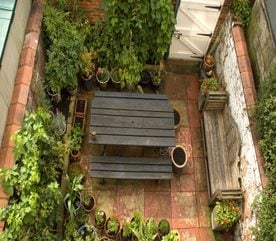Make Your Own City Garden
The concrete paving behind her city-centre basement flat is not quite 8m wide and 5.5m long (26x18ft), but is crammed full of plants. One corner has a bed of soil, but pots and planters provide most of Sheila’s gardening opportunities.

With such a small space, Sheila soon realised that the only way to grow is up, and the house wall and garden fences are all but obscured by scrambling clematis, correas, forsythias, jasmines, pyracanthas, roses and a vine. Many of these stretch several metres from their copious plastic buckets, now hidden by other pots, and screen the rumble of E trains on the railway line that borders the plot. They also help to create the impression of a garden much larger than its true size.
Two roses float like clouds at the back of the garden, where they bridge the gaps between four chimneys, each 1.5m (5ft) tall, taken from the roof of the house. The small-flowered ‘Félicité Perpétue’, now 25 years old, mingles with the more open blooms of ‘Cooper’s Burmese’ in a froth of white.
The simple white dots of the roses set the scene for the whole garden. “In a small space it is often best to follow a simple colour scheme, so that as the eye travels around the overall impression is of harmony, not jolting contrasts,” Sheila advises. Her artist’s eye – she worked as a costume designer and is an accomplished water colourist – helps her to make the most of her palette. Whites from warm cream to almost blue are combined with a full range of greens and yellows.
A low wall around the garden’s planted area offers a perch for several containers, but other arrangements are lifted by being placed on an upturned pot, or on bricks. Sheila’s advice for using bricks in the garden is to get them from old storage heaters found in salvage yards: their deep ridges, or fins, give them an attractive shape and, because they have been fired, they are resistant to fluctuating temperatures, Indian summers and harsh winter frosts. Raising a pot can offer a new perspective on a familiar plant. The spray of blue grass, Festuca glauca, at the top of the saucepan stand shimmers in the sunlight in a way it never would at ground level, and the tiny pink flowers of the sedum planted beside it catch the eye when they are at head height.
A Taste for the Unusual
In the centre of the garden a retirement gift – a three-tiered wire jardinière – houses a generous collection of pots that changes with the seasons. On the bottom tier in summer, common pansies sit alongside a Kleinia tomentosa, a strange-looking silver plant with fleshy ‘fingers’, which Sheila inherited from a friend’s conservatory. “He always had trouble growing it,” she says, “but here it has been no problem. It just needs to go in for the winter.”
This odd-looking specimen is not alone in the garden. “I think I have more of a botanical streak than a horticultural one,” Sheila says, and, as you explore, her collecting habit soon becomes apparent. Among a medley of hostas now so old Sheila claims to have forgotten what most of them are, is a Chinese variety, Hosta plantaginea ‘Grandiflora’, which grows only in full sun, producing an extraordinarily fragrant, white flower in September. But it’s not just the plants which come from far afield. Mulching her pots, rocks from the Sahara sit next to less exotic holiday mementoes gathered by her great nieces and nephews.
Order in the Jumble
Keeping things small is Sheila’s perennial challenge. “In all my years of gardening,” she says, “I still haven’t learnt how big things grow.” But big-leaved plants with mighty proportions are among her particular favourites, and fill gaps all over the garden.
As well as the many hostas and a huge Fatsia japonica at the side of the house, she has a shady corner of ferns and a bank of dark-leaved perennials including Heuchera ‘Palace Purple’, ‘Persian Carpet’ and ‘Chocolate Ruffles’ and an umbrella plant, Darmera peltata, whose rhubarb-like leaves change colour through the year from light green to bronze in autumn, and can grow to almost twice the size of a dinner plate.
Another monster leaf belongs to the Rheum, or ornamental rhubarb, but still Sheila hankers for more: “I dare not give in and buy a gunnera… and I’d love a Crambe cordifolia, but friends keep telling me, ‘Sheila, you can’t have one!’ It’s true: it would be far too big.”
“I’m always reminding people, ‘green is a colour, too’.”



